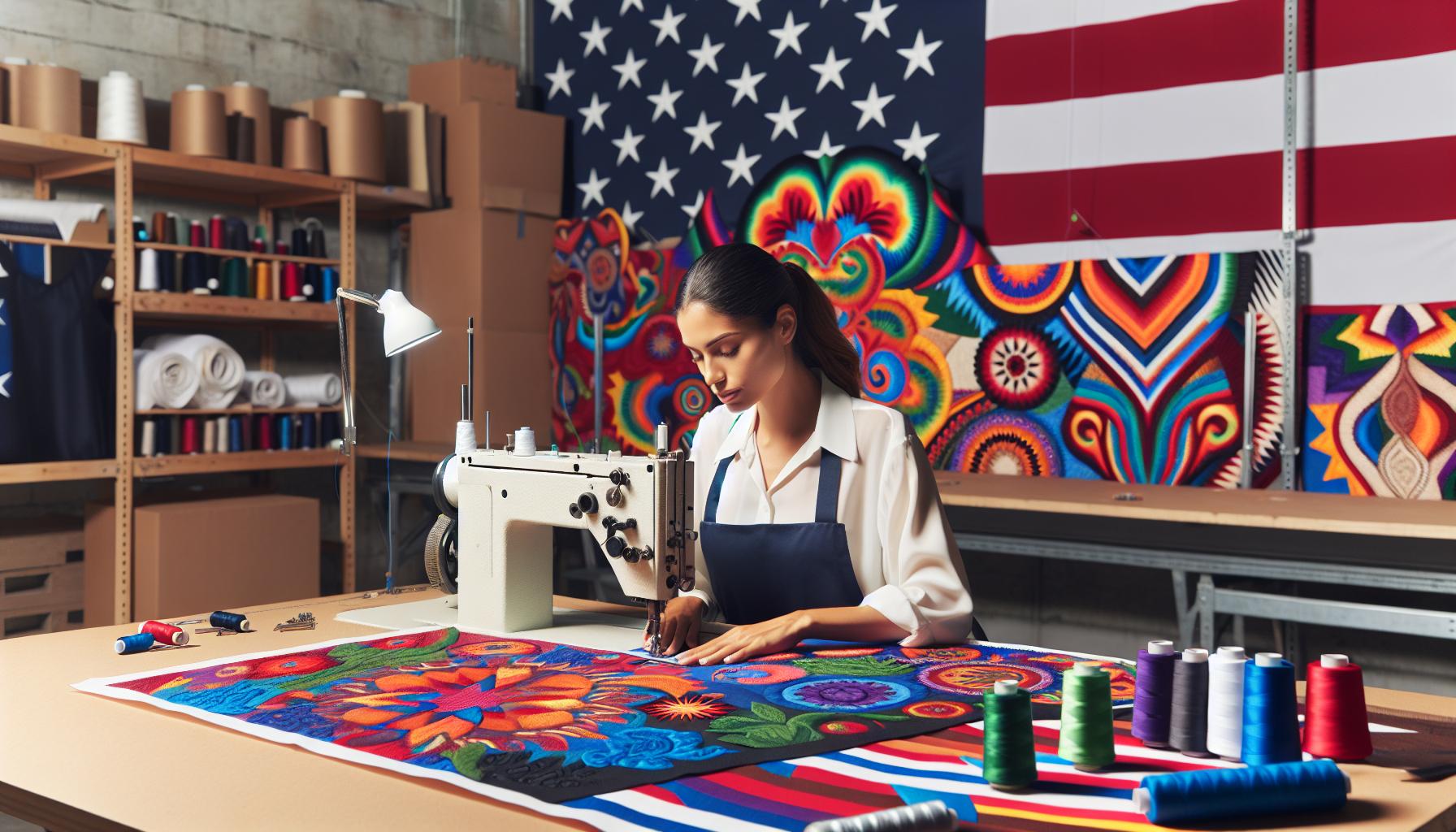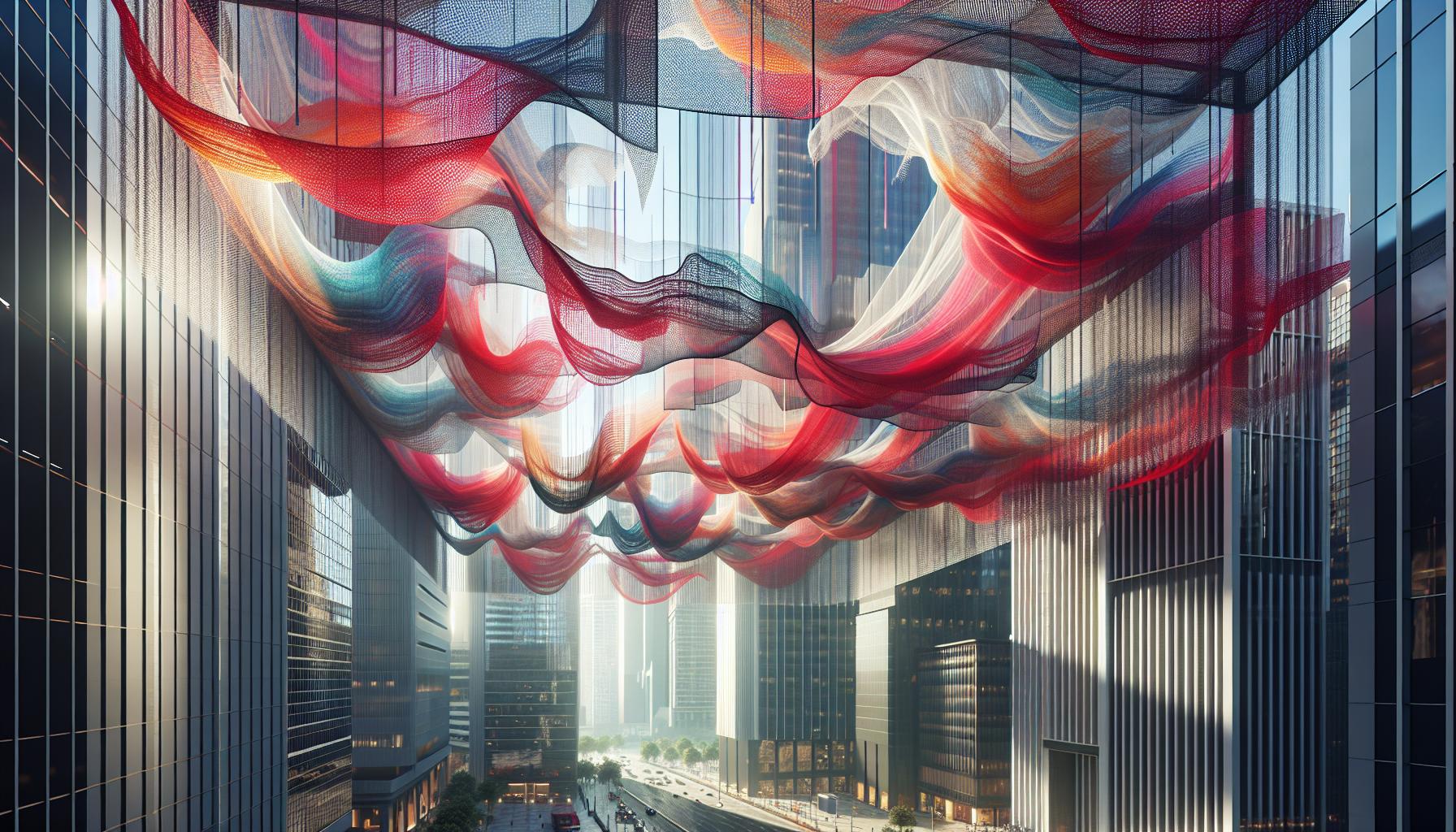Fabric art installations transform ordinary spaces into extraordinary visual experiences that captivate and inspire. These mesmerizing creations blend the softness of textiles with bold artistic vision to produce immersive environments that challenge our perception of space and form.
From suspended silk cascades to intricate yarn compositions modern fabric artists are pushing the boundaries of traditional textile art. They’re creating large-scale installations that invite viewers to explore touch and interact with their surroundings. Whether it’s a delicate web of crocheted threads spanning across building facades or vibrant fabric tunnels that wind through gallery spaces these installations prove that fabric isn’t just for wearing – it’s a powerful medium for artistic expression.
Fabric Art Installation
Fabric art installation transforms textiles into three-dimensional artistic expressions that interact with space. These site-specific creations combine various textile materials with architectural elements to create immersive environments.
History and Evolution of Textile Art
Textile art installations trace their origins to ancient civilizations using fabric for ceremonial displays. The 1960s marked a pivotal shift when artists like Magdalena Abakanowicz pioneered large-scale fiber works. Artists in the 1970s pushed boundaries by incorporating suspended textiles into gallery spaces. The Fiber Art Movement emerged during this period, establishing fabric as a legitimate medium for contemporary art. Notable exhibitions at the Museum of Modern Art in 1969 showcased groundbreaking textile installations, setting new standards for fabric-based artistic expression.
Contemporary Fabric Installation Techniques
Modern fabric installations employ diverse methods to manipulate textiles in space. Artists use draping techniques to create flowing forms with silk chiffon fabrics. Tension-based installations utilize stretched fabric panels to divide spaces. Digital fabrication integrates LED lighting systems into woven structures. Contemporary techniques include:
- Binding methods using industrial-grade tension cables
- Pleating systems with computerized folding patterns
- Suspension frameworks incorporating modular components
- Heat-setting processes for permanent textile formations
- Digital projection mapping onto fabric surfaces
These techniques combine traditional textile manipulation with modern technology to create dynamic spatial experiences.
Materials and Tools for Fabric Installations

Successful fabric art installations depend on selecting appropriate materials and utilizing specialized tools for proper execution. The combination of high-quality textiles and professional-grade equipment ensures durability and aesthetic impact in large-scale installations.
Types of Fabrics and Textiles
Fabric installations incorporate diverse textile materials based on specific project requirements. Natural fibers like silk, cotton, linen exhibit distinct draping characteristics and light interaction properties. Synthetic materials such as polyester, nylon, spandex provide durability and stretch capabilities for dynamic installations. Technical textiles including fire-retardant fabrics, UV-resistant materials, weatherproof synthetics ensure safety and longevity in public spaces. Specialty fabrics like organza, tulle, voile create translucent effects while heavyweight materials such as canvas, felt, wool suit structural installations. Digital printing compatible fabrics enable custom patterns and imagery integration into large-scale works.
Essential Equipment and Supplies
Professional fabric installations require specific tools for precise execution. Industrial sewing machines with walking foot attachments handle heavy materials up to 1/2 inch thick. Mounting hardware includes aircraft cable (1/16 to 1/8 inch diameter), turnbuckles, cable clamps, eye bolts rated for 500+ pounds. Installation tools comprise laser levels, impact drills, rigging equipment, scissor lifts for heights up to 40 feet. Fabric manipulation tools include steam irons, heat guns (temperature range 200-1000°F), custom pleating boards, blocking frames. Safety equipment features fall protection systems, fire-resistant staging materials, load-rated carabiners, proper ventilation systems for adhesive use.
Notable Fabric Installation Artists

Fabric installation artists transform spaces through innovative textile manipulations creating immersive environments that challenge spatial perception. Their works demonstrate the evolution of textile art from traditional craft to contemporary artistic expression.
Influential Contemporary Artists
Chiharu Shiota creates room-spanning webs using red yarn to explore themes of memory connection. Do Ho Suh crafts architectural replicas from translucent fabrics exploring cultural displacement identity. Janet Echelman suspends massive fiber sculptures between buildings incorporating LED technology weather data. Ernesto Neto designs biomorphic installations using stretchy lycra filled with aromatic spices. Gabriel Dawe constructs prismatic thread installations that manipulate light create rainbow effects in architectural spaces.
Groundbreaking Historical Artists
Magdalena Abakanowicz pioneered large scale fiber art through her monumental sisal sculptures in the 1960s. Lenore Tawney transformed weaving into sculptural forms through her groundbreaking “woven walls” installations. Sheila Hicks elevated fiber art through architectural scale installations combining traditional weaving techniques with contemporary materials. Claire Zeisler developed innovative knotting techniques creating free standing fiber sculptures. Faith Ringgold integrated narrative storytelling into textile installations through her story quilts addressing social justice issues.
Popular Installation Styles and Methods

Fabric art installations encompass diverse techniques that transform spaces through strategic material placement. Each style creates unique spatial experiences through specific mounting methods materials.
Suspended Fabric Installations
Suspended installations float fabric elements from ceiling points through tension cables or custom rigging systems. Artists create dramatic vertical drops using lightweight silk chiffon sheets cascading from 20-30 feet high. Advanced suspension systems incorporate motorized pulley mechanisms that adjust fabric heights dynamically. Metal frameworks support complex geometric configurations with fabrics stretched between multiple anchor points. Popular suspension materials include aircraft cable rated for 250-500 pounds shear strength nylon rope with UV protection coatings climbing rope with safety certifications.
Wall-Mounted Textile Art
Wall-mounted textile installations integrate fabric directly onto vertical surfaces using specialized mounting hardware. Artists layer multiple textile panels to create dimensional effects reaching 4-8 inches from the wall surface. Tension mounting systems stretch fabric taut between discrete anchor points spaced 12-24 inches apart. Custom aluminum frames secure edges while allowing fabric to billow organically. Essential mounting materials include marine-grade stainless steel brackets powder-coated mounting plates commercial-grade hook loop fasteners industrial adhesives rated for fabric applications.
Interactive Fabric Environments
Interactive installations invite physical engagement through responsive textile elements. Motion sensors trigger fabric panels to shift position when viewers approach within 3-5 feet. Pressure-sensitive floor mats activate mechanical systems that alter fabric tension levels. LED arrays integrated into translucent textiles change colors based on visitor movement patterns. Key interactive components include Arduino microcontrollers programmable LED strips ultrasonic distance sensors capacitive touch panels conductive threads woven into fabrics. These systems transform static installations into dynamic environments that respond to human presence.
Creating Impact Through Scale and Space
Fabric art installations transform spatial perception through strategic placement and dimensional consideration. The interplay between textile elements and architectural spaces creates immersive experiences that engage viewers on multiple sensory levels.
Site-Specific Considerations
Site analysis forms the foundation of impactful fabric installations. Ceiling heights determine the vertical scope for suspended pieces while floor plans influence the horizontal flow of textile elements. Load-bearing calculations guide mounting points for large-scale works, ensuring structural integrity. Environmental conditions like air circulation patterns affect fabric movement and installation stability. Room acoustics impact the selection of textile densities and weaves. Traffic patterns inform placement decisions to maximize viewer interaction while maintaining safety clearances. Building codes and fire regulations dictate material choices and installation methods.
Lighting and Environmental Factors
Lighting design amplifies the visual impact of fabric installations through strategic illumination techniques. LED systems create dynamic color effects on textiles while natural light interaction showcases material translucency. Temperature control systems protect delicate fibers from heat damage through regulated ambient conditions. Humidity monitors safeguard textile integrity by maintaining optimal moisture levels. UV-resistant fabrics prevent color fading in sun-exposed locations. Ventilation systems minimize dust accumulation on fabric surfaces. Motion sensors trigger responsive lighting effects that enhance viewer engagement with the installation. Seasonal light variations influence material selection and positioning for outdoor installations.
Conservation and Maintenance
Fabric art installations require systematic preservation strategies to maintain their aesthetic impact and structural integrity over time. Professional conservation methods protect these delicate artworks from environmental factors while preserving their artistic intent.
Preserving Textile Installations
Regular maintenance protocols safeguard fabric installations through documented cleaning schedules and inspection routines. Professional art conservators employ specialized techniques to address specific textile compositions:
- Surface cleaning with micro-vacuum systems removes accumulated dust particles
- Spot treatment protocols target localized stains without compromising fabric integrity
- Documentation systems track condition changes through detailed photography logs
- UV-protective coatings shield delicate fibers from light damage
- Specialized repair techniques address tears or loose threads using conservation-grade materials
- Rotating display schedules limit continuous exposure to environmental stressors
Environmental Control Methods
Environmental monitoring systems maintain optimal conditions for fabric art preservation through precise control mechanisms:
| Environmental Factor | Optimal Range | Control Method |
|---|---|---|
| Temperature | 68-72°F | HVAC systems |
| Relative Humidity | 45-55% | Dehumidifiers |
| Light Exposure | 50-150 lux | UV filters |
| Air Quality | <10 μg/m³ dust | HEPA filtration |
Climate control equipment regulates temperature fluctuations while humidity monitors prevent moisture damage. Advanced air filtration systems eliminate airborne contaminants that accelerate fabric degradation. Light management protocols incorporate UV-blocking window films and timed lighting controls to minimize photochemical damage.
Fabric art installations represent a dynamic intersection of traditional textile craft and contemporary artistic innovation. These immersive creations continue to push boundaries while challenging our perception of space and artistic expression. From suspended silk cascades to interactive environments the medium has evolved into a powerful form of artistic communication.
Today’s fabric artists blend cutting-edge technology with time-honored techniques to create installations that captivate viewers and transform spaces. As this art form continues to evolve it promises even more exciting developments in the fusion of textiles architecture and digital innovation. The future of fabric art installations stands as a testament to human creativity and the endless possibilities of textile manipulation in contemporary art.



